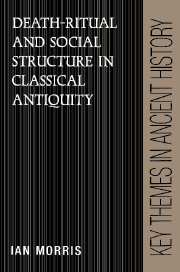Book contents
- Frontmatter
- Contents
- List of figures
- List of tables
- Preface
- Abbreviations
- 1 Map of sites in the Roman empire discussed in this book
- 2 Map of sites in Greece discussed in this book
- 1 The anthropology of a dead world
- 2 ‘Mos Romanus’: cremation and inhumation in the Roman empire
- 3 ‘Dem bones’: skeletal remains
- 4 Taking it with you: grave goods and Athenian democracy
- 5 Monuments to the dead: display and wealth in classical Greece
- 6 Famous last words: the inscribed tombstone
- 7 At the bottom of the graves: an example of analysis
- 8 Conclusion
- Bibliographical essay
- Bibliography
- Index
8 - Conclusion
Published online by Cambridge University Press: 02 December 2009
- Frontmatter
- Contents
- List of figures
- List of tables
- Preface
- Abbreviations
- 1 Map of sites in the Roman empire discussed in this book
- 2 Map of sites in Greece discussed in this book
- 1 The anthropology of a dead world
- 2 ‘Mos Romanus’: cremation and inhumation in the Roman empire
- 3 ‘Dem bones’: skeletal remains
- 4 Taking it with you: grave goods and Athenian democracy
- 5 Monuments to the dead: display and wealth in classical Greece
- 6 Famous last words: the inscribed tombstone
- 7 At the bottom of the graves: an example of analysis
- 8 Conclusion
- Bibliographical essay
- Bibliography
- Index
Summary
Cynics sometimes suggest that ‘progress’ in historiography is no more than a series of mutual misunderstandings, as historians rush to disprove things that others had never intended to say. In writing a methodological book like this I perhaps run even more of a risk of creating the wrong impression than I would in a more substantive work. I have argued that a kind of evidence which most ancient historians ignore is in fact a vital source; and that when historians have used it, it has generally been in the least appropriate ways. Some readers will find this annoying, incomprehensible or not worth the bother; but others, I hope, may see ways to extend their own research. I close with a summary of the points I have tried to make, but first I will set out a series of propositions which I have not made.
WHAT IS NOT BEING SAID
Burials are the ‘best’ source
Classicists who rely mainly on texts and those who rely mainly on archaeological evidence often act as if they were two sides in a competition, and one day an impartial observer will judge whose evidence is best and who wins the game. We have to take our evidence where we can find it; and my argument here has been that we need to combine as many genres as possible. Historians who write about community without using material evidence for rituals and archaeologists who write their monographs without reference to historical concepts both lose out.
- Type
- Chapter
- Information
- Death-Ritual and Social Structure in Classical Antiquity , pp. 200 - 204Publisher: Cambridge University PressPrint publication year: 1992



